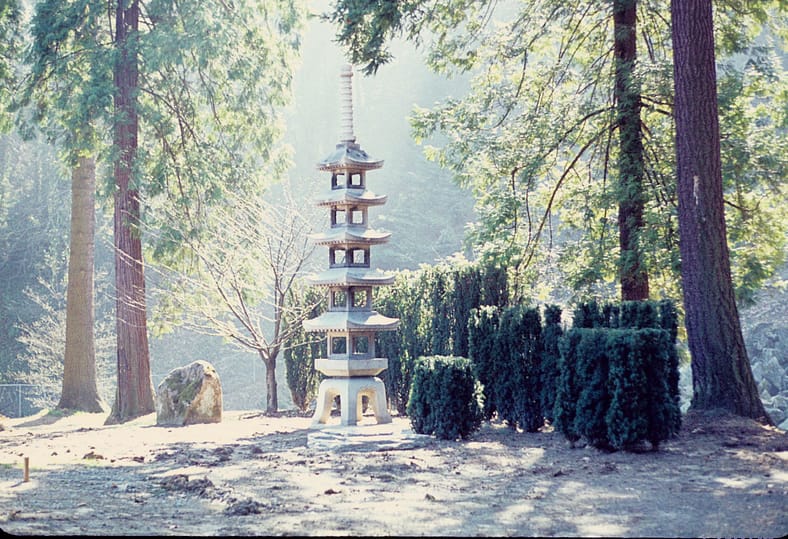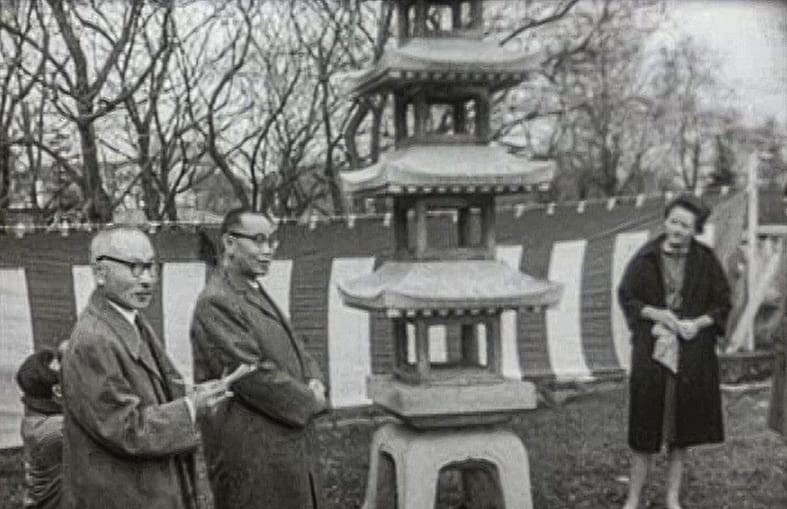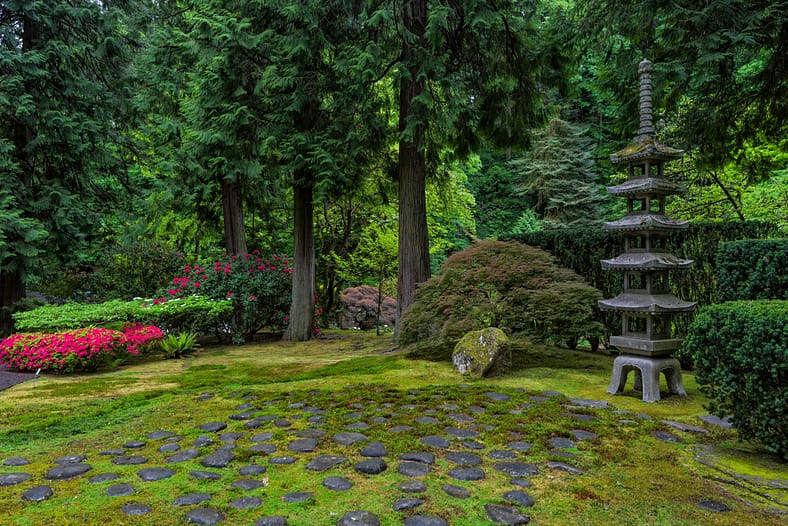
2024 marks the 65th anniversary of one of the United States’ oldest and strongest sister city relationships—Portland, Oregon in the U.S. and Sapporo, Hokkaido in Japan. This sister city relationship, which has fostered an everlasting friendship across the Pacific, has also come to be manifested in more tangible forms. One such example is our Sapporo Pagoda Lantern, a gift delivered to us in 1964 as our landscape was being built. Learn more about this stunning 18-foot stone lantern and why our friendship with Sapporo has been so vital to the establishment and continued success of Portland Japanese Garden.
Of all the many stone lanterns throughout Portland Japanese Garden, none might be as visually arresting as the Sapporo Pagoda Lantern. No matter which way it is approached, through the Wisteria Arbor, the Camellia Tunnel, or along the slope of Cherry Tree Hill, its towering 18 feet draw the eye immediately. Grand and stately, the lantern’s form is that of a goju-no-to, or five-story pagoda. This Buddhist architectural style is rooted in the Indian stupa. As the religion was transmitted across Asia, the stupa’s dome was transformed into a tower in China. It was this form that was exported to Japan in the sixth century when the faith was first introduced there. Notably, the Sapporo Pagoda Lantern’s finial top (hoju) is stylized as a lotus, a flower deeply associated with Buddhism.
Thought to be more than 100 years old, the Sapporo Pagoda Lantern is an impressive two tons in weight and is composed of highly regarded granite quarried from the island of Shikoku. The lantern had been on the grounds of the Sugawara Mansion in the city of Otaru, a northwest neighbor of Sapporo, Japan. Founding Portland Japanese Garden Board Member Vivian Abbot wrote in a 1964 press release that the property had once belonged to Motosaburo Kaneko, the first mayor of Otaru Ward and an entrepreneur who ran fishery, shipping, farming, and banking concerns.


Left: The bottom of the Sapporo Pagoda Lantern, still in Japan before its journey east. Right: Mayor Terry D. Schrunk in Sapporo looking at the gift that would be bestowed upon Portland. Photos: City of Portland (OR) Archives/AP/18484
The lantern would eventually be purchased by a band of organizations in Japan so the City of Sapporo could donate it an American municipality, one it had just become sister cities with, one that was in the process of establishing a Japanese garden. That city was Portland, and we are that garden. Comfortably ensconced on its mossy hill since 1964, the Sapporo Pagoda Lantern is a physical embodiment of the sister-city relationship between Portland and Sapporo. The story of how it came to Portland begins in our nation’s capital.
On September 11, 1956, President Dwight D. Eisenhower spoke to a crowded room of reporters in Washington, D.C. “I’m emboldened to talk because the purpose of this meeting is the most worthwhile purpose there is in the world today to help build a road to an enduring peace,” the President shared. “The work that we expect to do is based on the assumption that no people want war; that all people want peace.” With that, Eisenhower helped launch one of the most enduring peacebuilding initiatives in American history, the sister cities movement.
While sister-city relationships had existed prior to 1956, the White House Conference on Citizen Diplomacy catalyzed a new era of international partnerships just a decade past the tragedies of World War II. Among the most poignant relationships that would arise would be between Japanese cities and American ones that were still recovering from the wrongful expulsion and incarceration of their residents of Japanese ancestry, including Portland.
That Portland would seek friendship with a Japanese city marked a sea change in its perception of the nation and its people. During the WWII era, Portland had the distinction of being the only major American city on the West Coast to revoke municipal business licenses for Issei (first generation Japanese immigrants). Its City Council also passed a resolution in favor of internment and the concentration camps its Japanese constituency would be condemned to. Attitudes had changed by 1952 when Mayor Dorothy McCullough Lee and Portland Chamber of Commerce President Edgar Smith accepted 2,000 cherry seeds from school children in Japan in a public event.
By the end of the 1950s, Portland was actively considering sister-city relationships in Japan. Two contenders were named in the pages of The Oregonian: the southern city of Shizuoka and the northern city of Sapporo. In the autumn of 1959, Mayor Terry D. Schrunk and a cohort of Portland leaders visited both. It is no secret which city was chosen on November 17.

The goals of fostering friendship between cities quickly took off. Sapporo would be inspired by their contemporaries across the Pacific and engaged in a months-long flower planting campaign to encourage the natural beauty Portland so easily expressed. Portland, meanwhile, was already quite captivated with the art of Japanese gardening. In the late 1950s, civic leaders had already started advocating for a Japanese garden to fill the void left by the old Portland Zoo in Washington Park. In the mind of Schrunk, the relationship with Sapporo and the establishment of a Japanese garden in Portland were intertwined. In a 1962 New Year’s letter he wrote to his counterpart, Mayor Yosaku Harada, Schrunk noted:
“We sincerely trust that this beautiful Garden with its ancient origin and philosophy will complement our own garden culture and add to the growth of friendship and understanding between Oregon and Japan in general and between Portland and Sapporo specifically. Many cities throughout the world have sister cities, but I doubt that any affiliation has the depth of personal friendship and understanding that our program has.”
The cities also exchanged meaningful and permanent installations. Portland gave Sapporo a Benson Bubbler, its iconic drinking fountain with four bowls of perpetually bubbling water. It now resides in the city’s Odori Park, an impressive green swath that runs southwest from the Sapporo TV Tower, a famous tourist destination. Sapporo’s gift would come to bear its name as the Sapporo Pagoda Lantern and it would similarly be situated in a place that happily welcomes visitors from around the world: Portland Japanese Garden.

In November 1963, after receiving Schrunk and his visiting party in Japan, Harada, Sapporo’s mayor, announced that his city would donate the Sapporo Pagoda Lantern to Portland for its Japanese garden. Harada, who had participated in groundbreaking ceremonies for the Garden in 1961, noted that it had been crafted by an artist of the Imperial Court at the end of Japan’s Meiji Era (1868-1912). Later in a letter to Schrunk, the Japanese leader wrote:
“I sincerely hope that this elaborated product modeled after a pagoda will be set in the Japanese Garden which, I am glad to hear, is being constructed in your City of Portland and that this gift from your sister city will remain for long as a token of our good will and everlasting friendship toward our sister city in the United States.”

When all 13 crates holding its parts arrived in Portland in 1964, however, Portland Japanese Garden was not yet ready to receive it as they had to prepare a concrete base to support its might. The first place to display this highly articulated piece of handcrafted art in Oregon would fittingly be Portland Art Museum, timed to a new exhibition of Japanese screens. Later that year, it would be installed where it still resides today in the Strolling Pond Garden. Completing the tableau that features the Sapporo Pagoda Lantern are towering Douglas firs and cedars giving it shelter, evergreen hedges placed asymmetrically behind it, a maple that turns fiery red in autumn, and several stones, some large and several smaller ones laid in front.

These smaller stones were removed from Dodge Park, a recreation spot near the Sandy River outside Portland. Put into position by the organization’s original designer, Professor Takuma Tono of Tokyo Agricultural University, they together resemble the form of Hokkaido, the prefecture that claims Sapporo as its capital. One stone that showcases a reddish hue in wet weather was taken from Terrebonne, Oregon, a mostly rural stretch north of Bend. It is placed where Sapporo is relative to the rest of its northern island home.

This would not be the final gifts exchanged between Portland and Japan. In 1988, Sapporo commissioned a sculpted water fountain from local Oregon artist Don Wilson that now stands near the Pavilion in honor of our organization’s 25th anniversary. Just a year later, business leaders based in Hokkaido gave Portland the Sapporo Bell, a “large scale sound installation,” now found outside the Oregon Convention Center in honor of the 30th anniversary of the sister-city relationship. In 2019, as Portland and Sapporo celebrated 60 years of friendship, two hand-carved wooden planks that had been on display at Portland Japanese Garden joined the Bell. One crafted by Ainu artist Mamoru Kaizawa and another by Chinook artist Greg A. Robinson, they had been featured in a Garden exhibition featuring the work of indigenous artists in both nations. Later in October of the same year, Portland Japanese Garden commissioned a handcrafted replica of our Peace Lantern and installed it in Nakajima Park in Sapporo in a ceremony that included Portland Mayor Ted Wheeler and Sapporo Mayor Katsuhiro Akimoto.

Just over 80 years ago and in the throes of war, the idea of a longtime friendship between American and Japanese citizens would have been difficult to imagine, but a friendship blossomed despite it all. Even in the despair of World War II, there were enough people who sought the peace we have come to enjoy. In an increasingly divisive landscape today, we can look to the Sapporo Pagoda Lantern and be reminded of the quiet power of friendship and good will.
